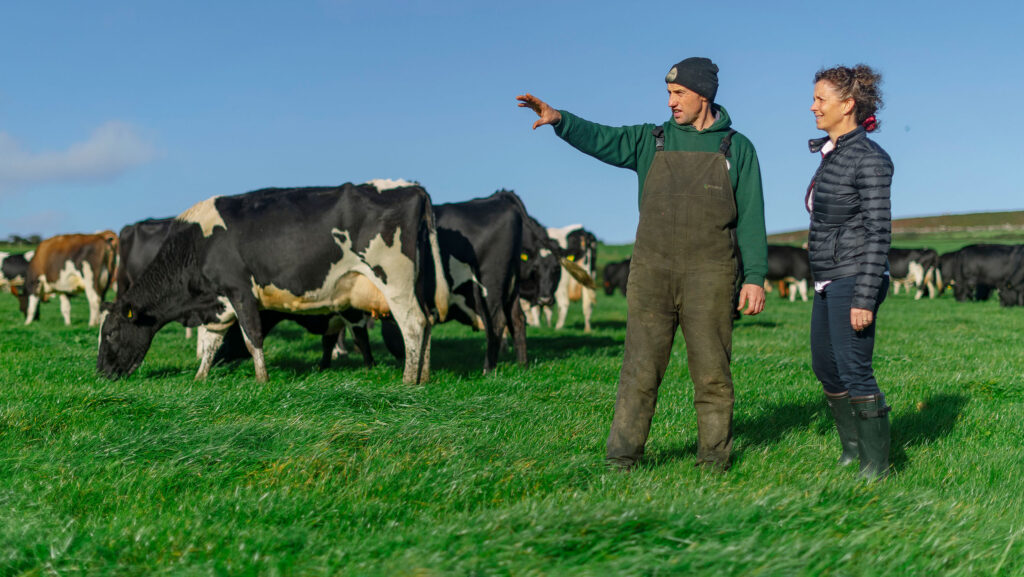Climate change moves the grass growth curve in Cornwall
 © Jim Wileman
© Jim Wileman Cornish dairy farmer and experienced grazing manager Chris Knowles is sharing updates about his 2024 grazing season with Farmers Weekly.
In this fourth and final instalment of the series, Chris reports on his “average” grass-growing year and noticeable changes from the effects of climate change.
See also: Late-summer grass growth refills silage stocks and grows heifers
Can you sum up your 2024 grass-growing year?
I hate to say it, but: average. We had a wet and difficult spring, then, since mid-April, it has been OK and manageable.
We lost a couple of weeks’ grazing in spring from about 20 March to 5 April and it will have cost us in milk production and grass growth.
We were still feeding silage to cows in at night, whereas normally we budget this for early March.
Why do you think this happened?
We are seeing more warm and wet autumns and winters.
On 31 October, it was looking like late April: we were seeing dark green on paddocks that hadn’t been grazed for a month, and bright green regrowth on those paddocks grazed three to five days earlier.
It’s very unusual for this time of year.
How is climate change affecting grassland management?
It’s easy to grow grass, it’s harder to manage it.
From mid-summer through autumn to January, we are getting a flush of growth, which is quite difficult to utilise, especially with shorter days and when it’s wet.
We find it difficult to make silage from it.
There doesn’t seem to be any gentle rain any more: it comes in massive volumes and the ground gets very wet, very quickly, which is hard to manage – whether you are trying to silage or graze.
Tell us what has gone well this year
Nothing has gone badly. For a spring-calving herd, it was difficult to recover from the horrendous start.
It took a good six weeks after calving, but the cows are milking well now.
They are grazing 8kg dry matter (DM) a cow, and housed at nights with 6kg DM a cow from baled silage, plus 2.5kg a cow of cake in the parlour.
Our fresh calvers – our new autumn block – are fully housed and on ad-lib bales, with 6kg of cake a day.
The herd average is 14kg a head, so I think autumn cows are producing 21kg and spring cows 12kg.
Was your first autumn calving successful?
It has gone OK. It has taken pressure off the grazing platform, and we have been able to build up a higher cover because cows have stayed inside as they calved.
Since early August – when we started drying-off cows – we have been able to reduce stocking rate, as 20% of the herd is now autumn calving.
What does this mean for your final grazing round?
We have one month of daytime grazing for our spring calvers, based on 8kg DM a day. We can keep the spring cows out until early December and have good cover to close up.
How did heifer grazing go this year?
Very well. We reseeded 10% of the heifer grazing area without being short of grass.
We made more silage off the area and increased our utilisation of it. I haven’t got the final total produced, but figures suggest it will be 10t DM/ha.
I’m pleased with that, as the heifer land is slightly poorer ground on the edge of a moor.
What’s that like compared with the rest of the farm?
The farm averages 12t DM/ha. We’re not far off – pretty close.
Any reseeding?
We put in 11ha (27 acres) of SAM3 herbal leys on 14 September. It was very wet afterwards, but with a warm soil – 13.5C – it got pretty good establishment.
There is green cover there now, but we won’t touch it until March.
If we had sown it in August, it would need grazing; instead, we will carry a low cover through winter ready for grazing in early March with milking cows.
Is there enough silage?
We did our last cut (third) in late August/early September and are just 100 bales short of our target of 2,500. We won’t take any more cuts now but will graze.
Our 6-7-month-old calves will outwinter and graze until January to save on cost, then move onto ad-lib bales on a sacrifice area.
And is it good quality?
Our first cut is OK, at 10.7 ME, though slightly disappointing. I don’t think we had enough sunshine when we cut on 6 May and while we were making it.
We are waiting for the second cut analysis to come back and haven’t tested the third cut yet, but analysis means we can then choose which class of stock has what.
What have you learned this year?
Seasons are changing: this year has confirmed to me we are seeing more extreme weather patterns. And I’m convinced we have to manage differently.
Timings are different in our grass growth curve. Overall, the volume of growth is similar, it is just growing at different times.
It is flattening out, without such high peaks, which should be easier to manage as it will be closer to demand.
We are growing at 20kg DM/ha a day at the moment, which is healthy. We have had no week over 80kg at peak growth this year, which doesn’t worry me.
Most weeks we have had very steady growth at 50-70kg/day, so if demand is 45-50kg/day, it is a surplus.
Plans for 2025’s grazing season?
Quite similar to this year: keep the principle of making more on our off-farm – we are taking dung over there to improve the soil; we will reseed another 10% of the platform and keep on working at our heifer grazing.
